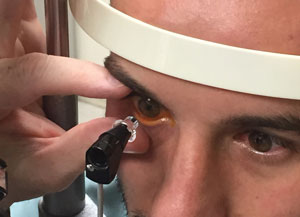 |
| Certain factors such as age and sex were correlated to patient risk of elevated IOP in this study. Photo: Natalie A. Townsend, OD. |
Researchers involved in the Laser in Glaucoma and Ocular Hypertension Trial’s (LiGHT) sister study, LiGHT China, recently reported that their cohort’s baseline higher IOP was correlated to younger age, male sex, thicker central corneal thickness (CCT) for primary open-angle glaucoma (POAG) patients, whereas only thicker CCT seems to be risk factors in patients with ocular hypertension (OHT). They also noted that IOP of glaucomatous or OHT eyes varies and reaches the peak value mostly at early morning or late afternoon and the trough value mostly at early afternoon.
The prospective randomized clinical trial included 622 glaucoma and 149 OHT patients who underwent Goldmann applanation tonometry at five intervals throughout the day. The researchers reported a mean baseline IOP of 20.2mm Hg for POAG patients and 24.4mm Hg for OHT patients. Greater central corneal thickness was correlated with higher IOP in both groups; male sex and younger age were correlated with higher IOP in the glaucoma group only.
“The role of age and its relationship with IOP still remains controversial,” the researchers wrote in their paper on the findings. “Numerous studies have discovered a positive association between older age and higher IOP level. However, in our study, multivariate analysis showed a significant negative correlation between age and IOP in POAG patients, consistent with the results of studies conducted in Asia populations.”
IOP reached a peak in the morning at 8am and decreased during the day, with a trough at 2:30pm. Mean IOP fluctuation was 3.4mm Hg in POAG and 4.4mm Hg in OHT eyes.
One interesting finding the researchers reported was that in both POAG and OHT eyes, the right eyes were more myopic than the left ones. This “confirmed the findings that right eyes have longer axial length than left eyes,” they wrote. “However, the interocular IOP difference noted only in POAG patients was difficult for us to explain […] IOP is an important indicator in the development and progression of glaucoma, thus fully understanding risk factors of elevated IOP and IOP fluctuations is of great significance.”
Yang Y, Zhang X, Chen Z, et al. Intraocular pressure and diurnal fluctuation of open-angle glaucoma and ocular hypertension: a baseline report from the LiGHT China trial cohort. Br J Opthalmol. January 27, 2022. [Epub ahead of print]. |

